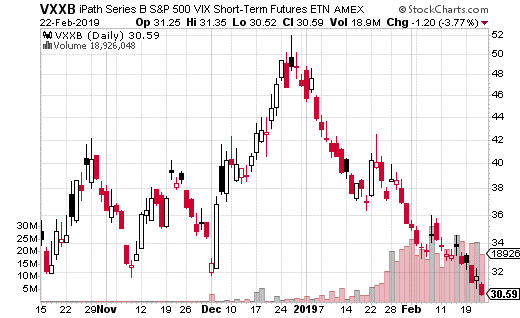After a loud end to 2018, Volatility has gotten quiet, perhaps too says Jay Soloff, Editor Options Profit Engine.
One of the most surprising elements of the stock market in 2019 is how little volatility there’s been so far. After all, 2018 – particularly the last three months – marked the return of volatility. There was no reason to think 2019 would be any different.
Heading into the new year, most of the key investor concerns were still on the table. These included the ongoing government shutdown, the trade war with China, interest rate increases and corporate earnings.
Well, the shutdown ended, the Fed agreed to be patient with interest rate hikes, corporate earnings have been mixed but okay, and the trade war with China seems to be nearing a resolution. Essentially, most of the biggest issues have not turned out to be that damaging.
That’s not to say the coast is entirely clear. There does seem to be some contraction going on with the economy. And, if the domestic and global economy start to show weakness, it could definitely take a toll on the forward-looking stock market.
But for now, there are good reasons why stocks have been going up and volatility has been going down. Mostly, there just isn’t a lot of negativity out there. Investors had so many things to be worried about previously, these days it’s downright sunshine and lollipops.
Nevertheless, as much as the crowd doesn’t expect anything crazy to happen over the next week or so – you never can tell. It only takes one surprising headline or news story to break, which can completely alter the dynamic of the market. And with volatility so cheap (relatively), it wouldn’t be a stretch to see some big players snatch up inexpensive options.
In fact, one trader is taking a flier on a big move in volatility happening in the coming week. But this trader isn’t just betting on a possible big move higher, the strategy could also work if volatility continues to plummet before next expiration.
Strangles
The strategy is called a strangle and it involves buying a call and put in the same expiration but at different strikes. That means a big move in either direction could result in a winning trade. In this case, the strangle purchased was in iPath Series B S&P 500 VIX Short-term Futures ETN (VXXB).
The trader paid $1.42 for 1,500 of the 30.5 puts and 31 calls in March 1 options with VXXB trading at $30.85. That means breakeven points occur at $32.27 and $29.43. Above or below those points is where the trader makes money. Max loss is only the premium spent, or $213,000. On the other hand, the trade earns $150,000 for every dollar above or below the breakeven points.

Generally, I’m not a fan of week-long strangles that cost over $1.00. That is, the trade is only going to last one week until expiration and requires something like a 5% up or down move in short-term volatility just to break even. However, volatility has been very quiet, almost too quiet.
If this is the sort of trade that interests you, considering paying up and using a further out expiration. You can reduce some of the cost by going a little wider on your strikes. For instance, the 29-32 (29 put, 32 call) strangle for March 15 costs $1.65. You are buying an extra week of time and only spending about 25¢ more (than the above strangle) by using slightly wider strikes.





















